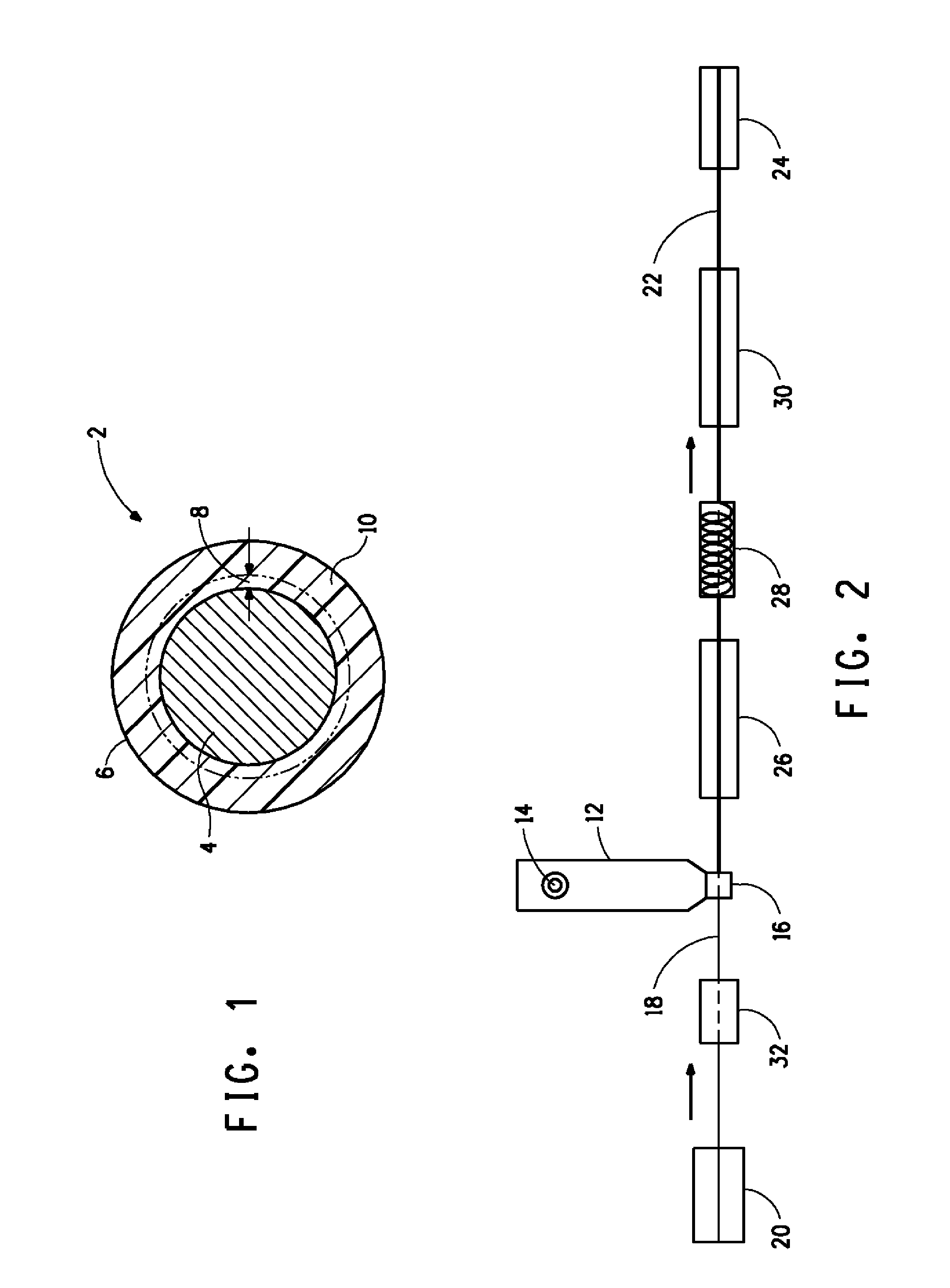Adhesion of Fluoropolymer to Metal
a fluoropolymer and metal technology, applied in the direction of plastic/resin/waxes insulators, insulation conductors/cables, synthetic resin layered products, etc., can solve the problems of reducing the electrical performance of cables, exposing the conductor to chemical attack, and separating the insulation from the electrical conductor, so as to improve the adhesion of insulation
- Summary
- Abstract
- Description
- Claims
- Application Information
AI Technical Summary
Benefits of technology
Problems solved by technology
Method used
Image
Examples
example 1
[0109]Lengths of several of the fluoropolymer insulated wire obtained in Example 1 are subjected to induction heating, one length at a time. After the 10 sec. exposure to induction heating within the induction coil, the test length of each fluoropolymer-insulated wire is allowed to cool and is then tested for the strength of the adhesive bond between the insulation and the wire. The induction heating in this Example is static in that the length of fluoropolymer-insulated wire is stationary during the induction heating. The 10 sec exposure is the amount of time that the electrical circuit powering the induction coil is turned on.
[0110]After exposure to 45% and 55% power for the induction coil, the strip forces for the insulated wire used in this Example are essentially unchanged from the less than 4 lb (1.8 kg) strip forces obtained with no induction heating. After exposure to 70% power, a sharp increase in strip force is observed for the insulated wires tested. The wires insulated w...
example 2
[0114]In this experiment, the recrystallization step is carried out dynamically in line with the extrusion coating step as shown in FIG. 2. The extrusion conditions are the same as in Comparative Example 1 for the particular fluoropolymers 1, 3, and 8 tested in this Example.
[0115]Strip forces are determined on cables insulated with fluoropolymers 1, 3, and 8, and in the experiments of this Example, the exposure is to induction heating is controlled by exposed surface temperature of the fluoropolymer insulation, instead of % power of the induction coil. The exposed surface temperature is determined using an IR camera. The induction coil is rectangular in cross-section, measuring 7 / 16 in (1.1 cm)×⅞ in (2.2 cm). The strip force when no induction heating is used in less than 4 lb (1.8 kg) for each cable. This is the strip force existing prior to recrystallization. At the surface temperature of 180° C., the strip force (after cooling) for the insulations of fluoropolymers 1 and 8 increas...
example 3
[0116]Hydrolytic stability of the adhesive bond is tested for several of the insulated wires (cables) of the Comparative Example 1 after quiescent remelting of the insulation region at the wire interface according to Example 2. For the cable using fluoropolymer 4, the strip force decreases by 50% from the immersion in boiling water. The decrease in strip force for the fluoropolymer insulation using fluoropolymer 3 is 20%. The insulations using the fluoropolymers 2 and 6 result in a decrease in strip force of no more than 2%. Fluoropolymers 2 and 6 both possess side-chain polar functionality, whereas fluoropolymers 3 and 4 do not. Strip force is measured by the procedure of strip force electrical cable described above.
PUM
| Property | Measurement | Unit |
|---|---|---|
| Fraction | aaaaa | aaaaa |
| Temperature | aaaaa | aaaaa |
| Force | aaaaa | aaaaa |
Abstract
Description
Claims
Application Information
 Login to View More
Login to View More - R&D
- Intellectual Property
- Life Sciences
- Materials
- Tech Scout
- Unparalleled Data Quality
- Higher Quality Content
- 60% Fewer Hallucinations
Browse by: Latest US Patents, China's latest patents, Technical Efficacy Thesaurus, Application Domain, Technology Topic, Popular Technical Reports.
© 2025 PatSnap. All rights reserved.Legal|Privacy policy|Modern Slavery Act Transparency Statement|Sitemap|About US| Contact US: help@patsnap.com


